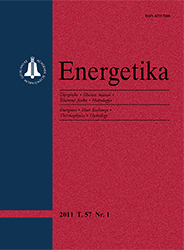 ISSN 0235-7208 |
2011 m. Nr. 1 The downshift of the electrical percolation threshold in polyisoprene-nanostructured carbon composites
In our previous research, the polyisoprene-nanostructured carbon composite (PNCC) has been approved as a promising material to be used as a low-pressure sensor. The main advantage of PNCC is its hyperelastic flexibility as compared with conventional piezo-ceramic pressure sensors as well as the outstanding sensitivity to small (<1 Bar) pressures. The PNCC is elaborated by incorporating highly structured particles of a good conductor (Printex XE2 carbon black) and necessary curing ingredients into the raw elastomer matrix (Thick Pale Creppe natural polyisoprene) and subsequent vulcanization afterwards. One can find in literature that the final electric properties of the composite greatly depend on the mixing method used. In our work, we use an ultrasound source as an alternative method to disperse the nanostructured filler. Roll-mixed, mechanically mixed in solution and ultrasound-mixed in solution PNCC samples were made. Their critical electrical percolation concentrations were determined and critical indexes were calculated for all types of PNCCs using linear trendlines on log–log plots. The piezoresistive behaviour of such composites was evaluated and compared. Keywords: polyisoprene, natural rubber, carbon, nanostructured, composite, piezoresistivity |
Numeriai:
2011 - T.57 Nr.1, Nr.2, Nr.3, Nr.4 2010 - T.56 Nr.1, Nr.2, Nr.3-4 2009 - T.55 Nr.1, Nr.2, Nr.3, Nr.4 2008 - T.54 Nr.1, Nr.2, Nr.3, Nr.4 2007 - T.53 Nr.1, Nr.2, Nr.3, Nr.4 2006 Nr.1, Nr.2, Nr.3, Nr.4 2005 Nr.1, Nr.2, Nr.3, Nr.4 2004 Nr.1, Nr.2, Nr.3, Nr.4 2003 Nr.1, Nr.2, Nr.3, Nr.4 2002 Nr.1, Nr.2, Nr.3, Nr.4 2001 Nr.1, Nr.2, Nr.3, Nr.4 |